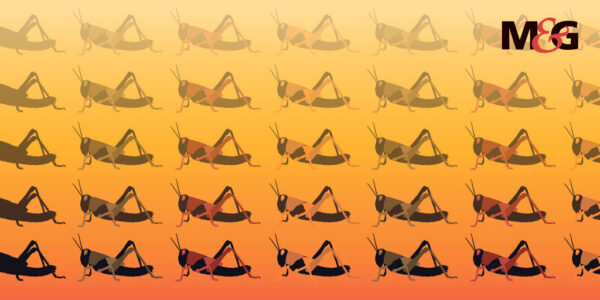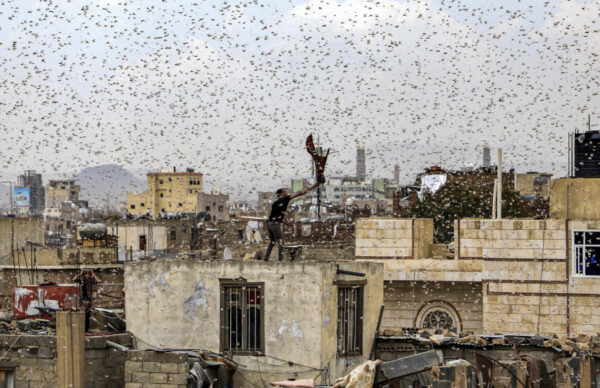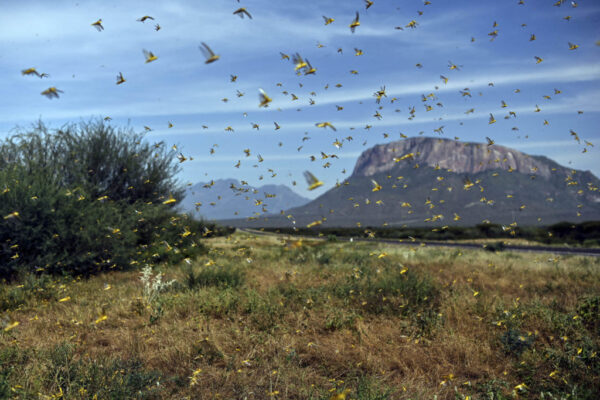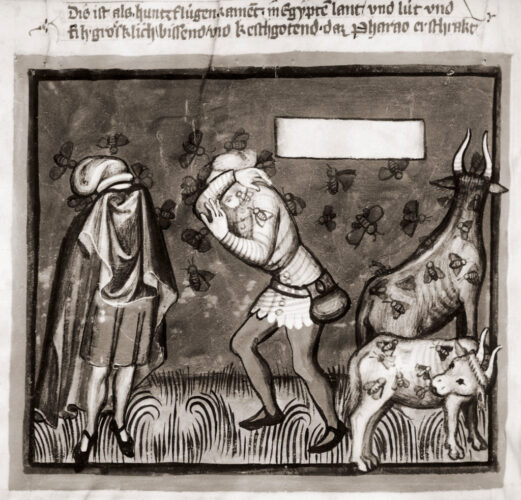PBS: Escaping Eritrea … [Read More...] about ካብ ውሽጢ ቤት ማእሰርታት ኤርትራ
The Year of the Locust
Simon Allison |21 Feb 2020|Mail & Guardian
“In appearance the locusts were like horses prepared for battle: on their heads were what looked like crowns of gold; their faces were like human faces, their hair like women’s hair, and their teeth like lions’ teeth; they had breastplates like breastplates of iron, and the noise of their wings was like the noise of many chariots with horses rushing into battle” —The Bible, Revelation 9:7-10

The Empty Quarter does not get a lot of water. This is one of the harshest deserts in the world, centred in the triangle of land that connects Saudi Arabia, Oman and the United Arab Emirates, and even today it is a place where humans tread with extreme caution. “It is a bitter, desiccated land which knows nothing of gentleness or ease,” wrote Wilfred Thesiger, the explorer, in Arabian Sands.
Thesiger made his name by becoming one of the first Europeans to traverse the Empty Quarter. He was in the Arabian Peninsula on official business: it was his job to survey and map the population of desert locusts. As inhospitable as the conditions in the Empty Quarter may be, it is here that some bands of locusts have made their home.
For the most part, these creatures live in small groups that are easy for the casual observer to miss. Their brown, chitinous exoskeletons (pictured left) are hard to spot against the backdrop of the desert. At this stage in their life cycle the insects mostly keep to themselves. It is a lonely existence, dedicated only to survival.
But sometimes — rarely — it rains in the Empty Quarter. And then everything changes.
Towards the end of May 2018, Cyclone Mekunu struck the Arabian Peninsula. Over the course of three days, more than 60cm of rainfall was recorded in Salalah, a port in Oman. The rains created lakes in the middle of the Empty Quarter, which typically receives just three centimetres of rain every year.
In the wet, desert locusts change their behaviour so dramatically that for a long time scientists assumed they were looking at another species. This is their gregarious phase (pictured right). Eggs that have lain dormant, sometimes for years, begin to hatch. Adults begin breeding at a furious rate: so quickly that, every three months, the size of the locust population multiplies by 20. There are so many of them that camouflage becomes impossible, so they turn bright yellow, a signal to predators that they are dangerous and may not taste very nice. The babies — known as hoppers, because they cannot yet fly — are bright pink, for the same reason.
In October 2018, just as the locusts’ second three-month breeding cycle was coming to an end, a second cyclone struck the Arabian Peninsula. Cyclone Luban dropped another 30cm of rainfall in the area. The hoppers feasted on the new vegetation. They grew into mature adults and began yet another breeding cycle.

Six months after that first cyclone, these small bands of locusts had grown into a swarms that were 400 times larger than the original locust population. Nine months on, the swarms were 8 000 times larger, and the locusts were running out of food. It was time to move.
The locusts have no king, yet all of them march in rank. — The Bible, Proverbs 30:27
Keith Cressman has one of the world’s most unusual jobs. His official title is Senior Locust Forecasting Officer for the United Nation’s Food and Agriculture Organisation (FAO). Unofficially, he is a locust whisperer, responsible for figuring out where locust swarms may form and to where they might travel once they do.
Accurate forecasting prevents locust swarms from spiralling out of control — out of human control, that is. The earlier that land can be treated, usually with insecticide, the less likely it is that the locusts can continue their exponential growth.
Half of Cressman’s job is science. From his office in Rome, he speaks to national-level locust monitoring units in two dozen frontline countries in North Africa, the Sahara Desert, the Arabian Peninsula and Southwest Asia. Each country is responsible for monitoring their desert areas, looking for any unexpected vegetation or unusually wet conditions that might encourage locusts to breed. These reports are supplemented by satellite data, as well as wind and weather predictions, and all the information is fed into a centralised locust tracking database, which goes back to the 1930s. (Humans have been tracking locusts for even longer than that; locust invasions are one of humanity’s oldest nemeses and records date back to Biblical times).
“The other 50 percent, dare I say, is intuition. It’s a feeling. I’ve been doing this for more than three decades,” he said. “I know all of these countries. I’ve been in the deserts of all of these countries. I know the people collecting the data … I have a feeling of how the locusts are going to respond, how they are going to behave. So I suppose the whole thing is half science, and half art.”
In 2018, watching from afar as the two cyclones hit Saudi Arabia, Cressman’s intuition kicked in. He knew that conditions were perfect for locust breeding. But because the area is so remote, and so vast, he did not appreciate the scale of the problem until the insects started to move.
When vegetation starts to run low, older locusts emit a scent that tells the others that it is time to leave. The insects are not strong enough to fly against the wind, and so they are hostage to it, being carried helplessly in the direction the prevailing current or monsoon. This is more ingenious that it sounds: wind always travels towards areas of low pressure, where it is more likely to rain.
In early 2019, over the course of several months, the winds carried the bulk of the desert locust swarms south into Yemen, where they found new vegetation and more good rain. Some locusts were carried north, into Iran, and from there into Pakistan.
Another generation of breeding was undisturbed, because the conflict in Yemen made it impossible for anyone to stage any kind of intervention.
The swarm was now 160 000 times its original size.

From Yemen, easterly winds in mid-2019 carried the locusts into Somalia and Ethiopia. Neither country is a stranger to locust invasions, but the sheer scale of this one was different. Although authorities were able to treat more than two million hectares of land with insecticide ahead of the arrival of the swarm, it was not enough. Ethiopia has just three planes that can be used for locust control, according to the Washington Post, while the ongoing conflict in Somalia means that there are some areas that the government cannot reach.
3 200 000 times bigger.
From his office in Rome, Cressman tracked the progress of the swarm with considerable alarm. He looked at the wind and weather patterns, and in mid-2019 he issued a warning to Kenya: watch out, the locusts are probably coming your way. In mid-October, he confirmed his warning: the locusts are definitely coming, and will be in Kenya by the end of the year.
At this stage, although the locust numbers were high, they were not yet catastrophic. Eventually the insects would run out of food, or climate conditions would not be right for new generations to hatch.
But not this time. “A single event tipped the whole thing into a very serious situation. And that was another cyclone,” said Cressman.
Cyclone Pawan made landfall in the Horn of Africa on December 7 2019, in almost exactly the same area as the locust swarms. Pawan was not an especially strong cyclone, but the unseasonal rain it dumped on the region’s arid landscape was enough to allow for two new generations of breeding, creating the most severe plague of locusts since 1986.
64 000 000.
1 280 000 000.
Their eyes humbled, they will emerge from the graves as if they were locusts spreading, racing ahead toward the Caller. The disbelievers will say, ‘This is a difficult day‘—The Quran 54:7-54:8
About 25 years ago, Baldwyn Torto and his team taught themselves to talk to locusts. Torto was, and remains, a chemist at the Nairobi-based International Centre of Insect Physiology and Ecology (ICIPE), where he was responsible for analysing the chemical signals that form the basis for locust communication.
“We were trying to understand the chemical language used by locusts to keep them cohesive, as a group. We were able to decode this chemical language. One language is used by the hopper stage, and when they become adults they switch to a different type of chemical language,” Torto said
Not only was ICIPE able to decode the locusts’ language, but it was able to produce chemicals to mimic it. “It’s exciting to discover a chemical and then you present it to the insect, and the insect responds in exactly the way you think it would … it allows you to use an insect’s own communication to modify the behaviour of the insect.”
This was a major breakthrough. Although it took a decade of field testing to be sure, now scientists can disrupt the locust breeding cycle by overwhelming hoppers with chemical signals from adult locusts. This leaves them confused, disorientated and vulnerable to predators. But it only works if you know where the locusts are breeding — and if you get there in time. For the current outbreak, it is already too late.
25 600 000 000.
As of mid-February, locust swarms had spread to 17 counties in Kenya, to 12 northeastern districts of Uganda, to Magwi county in South Sudan and to northern Tanzania. Swarms remain in northeastern Somalia and southeastern Ethiopia. Some of these swarms are the size of cities, measuring 40km in width and 60km in length. There are up to 80-million locusts per square kilometer.

Each day, each one of these billions of insects can eat their own body weight. In Kenya alone, they are consuming the same amount of food per day as Kenya’s entire population. They are passing through farms — many of which are subsistence farms — and leaving nothing edible behind them. As the locusts feast, 13-million people in East Africa are likely to go hungry.
“Locusts outbreaks can cover a whole region, and Africa is always more vulnerable, and small-scale farmers are the biggest losers,” said Torto.
Against the destructive power of the swarms, and their huge numbers, local authorities are powerless. Kenyan police have resorted to throwing tear gas grenades and shooting bullets into the swarms. There are not enough planes and equipment to distribute insecticide over such vast areas. Not that insecticides are necessarily the solution: they are indiscriminate killers that will decimate the populations of other insects such as bees and wasps, causing even greater long-term damage to the environment.

Torto wants to work on another solution. His hypothesis is that locust eggs release a chemical scent, which is the signal for them to hatch. If this scent can be isolated, reasons Torto, then it can be detected — and then the sands in which those eggs incubate can be treated with insecticide before the young hoppers emerge. ICIPE has approached donors to help with this research, but it’s a slow process. “We hope that the incubation period for donors is shorter than the incubation period for the eggs,” he said.
Until any new solutions are found, the areas affected by the locust swarms are at the mercy of the weather and the wind. Come June, the direction of the wind is expected to change, with the coming of the southwest monsoon. Only then is East Africa likely to see some respite, when the winds will drive the locusts back into the Red Sea, across the Arabian Peninsula and into parts of Pakistan, which is already facing a locust invasion of its own, one so severe that the country has declared a national emergency.
As the world warms, so locust invasions are likely to become more frequent and larger. “There is a link between climate change and the unprecedented locust crisis plaguing Ethiopia and East Africa,” warned António Guterres, the UN secretary general. “Warmer seas mean more cyclones generating the perfect breeding ground for locusts. Today the swarms are as big as major cities and it is getting worse by the day.”
512 000 000 000.
“I think as an entomologist, you have a tremendous amount of respect for them,” said the FAO’s Cressman. “When you actually see a swarm in the field, it’s the awesome power of mother nature, like when you see a hurricane or a tornado, it’s the same with locusts. These guys are professional survivors. They have so many tricks to survive the harshest weather.
“They’ve been through climate change several times and survived. How we fare is another story.”
